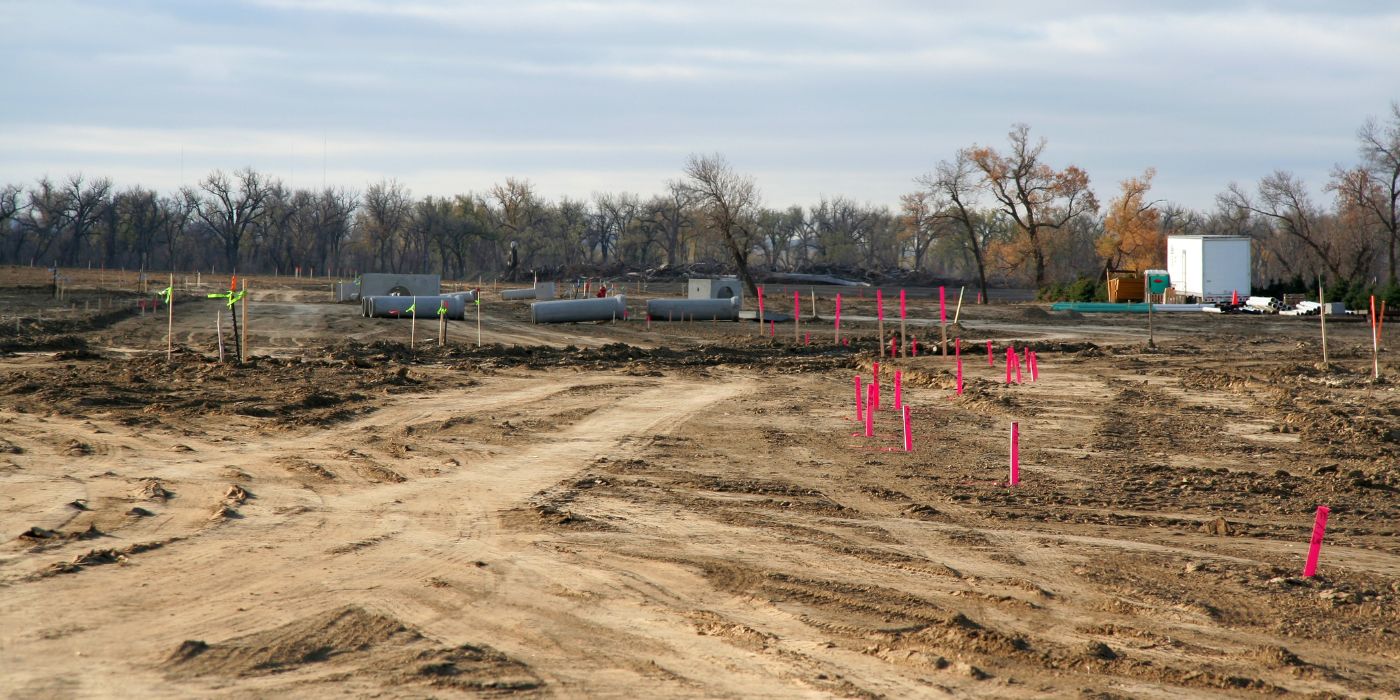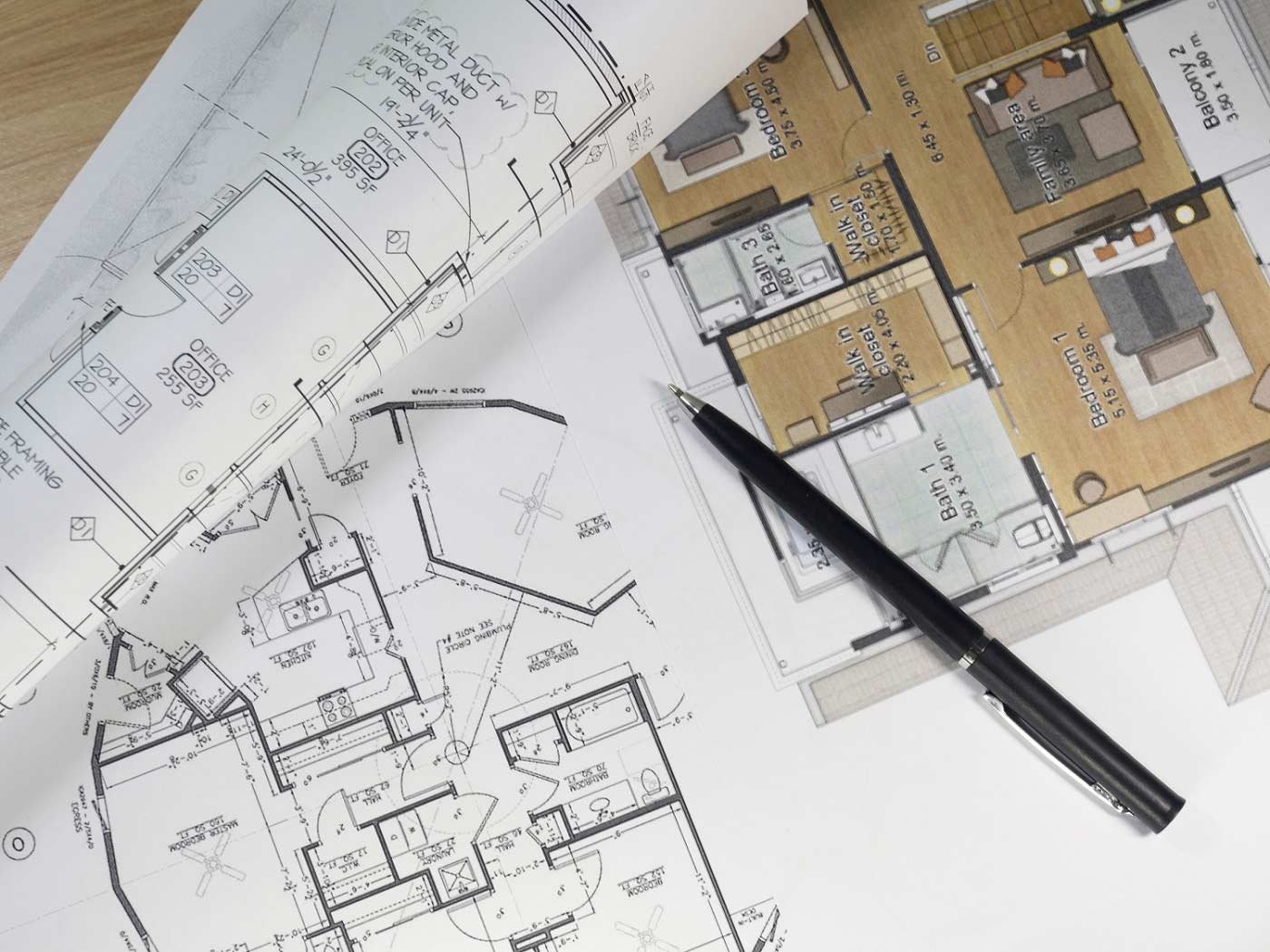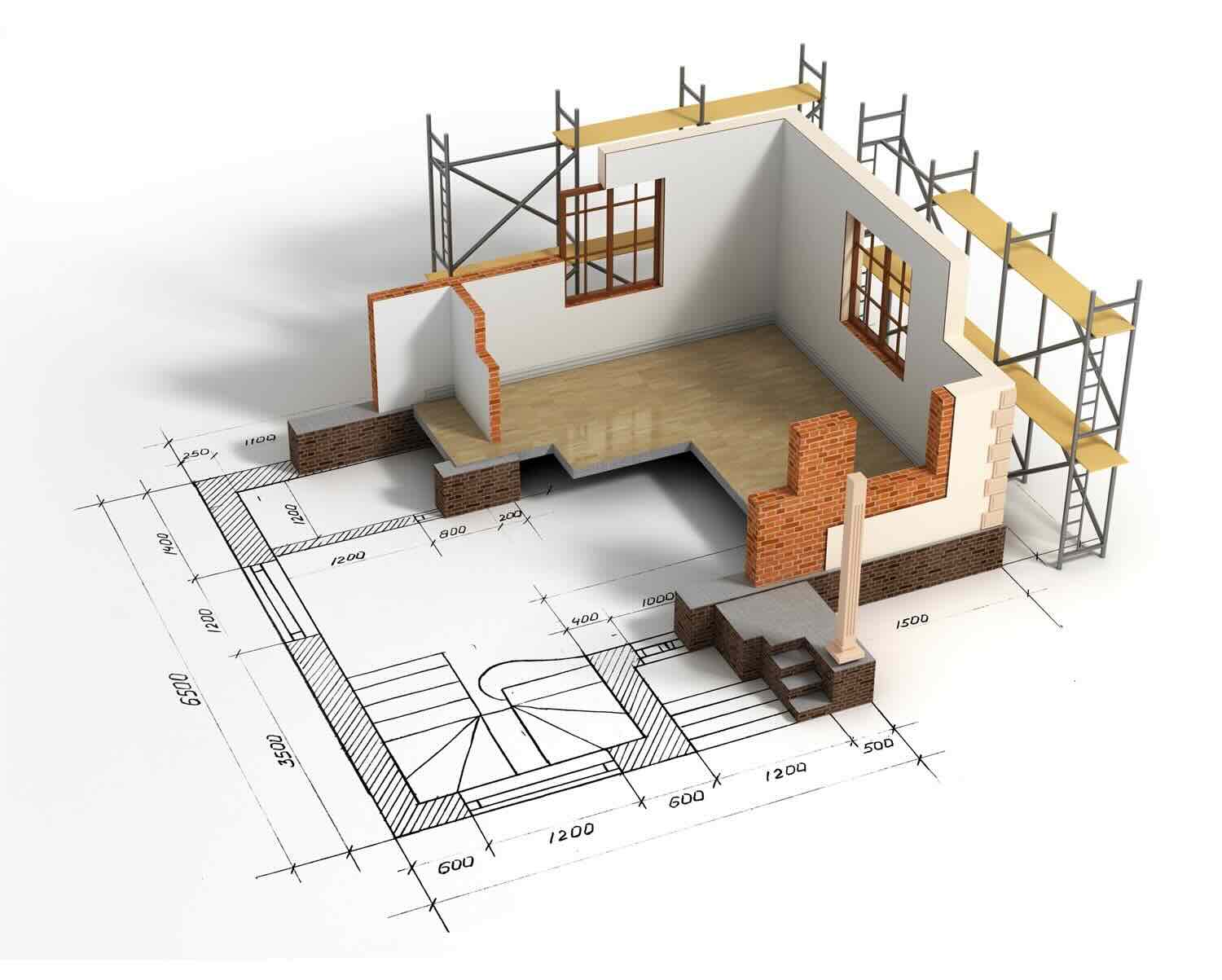Home>diy>Building & Construction>How To Read Plans For Construction


Building & Construction
How To Read Plans For Construction
Modified: January 4, 2024
Learn how to read plans for building construction projects with our step-by-step guide. Gain essential knowledge and skills to navigate blueprints and ensure successful construction projects.
(Many of the links in this article redirect to a specific reviewed product. Your purchase of these products through affiliate links helps to generate commission for Storables.com, at no extra cost. Learn more)
Introduction
Welcome to the world of construction plans. Whether you are a construction professional, an aspiring architect, or simply someone curious about how buildings are constructed, understanding how to read plans is essential. Construction plans are the blueprint for the entire building process, providing detailed instructions on everything from architectural design to electrical and plumbing layouts. They serve as a crucial communication tool between architects, engineers, contractors, and other professionals involved in the construction project.
In this article, we will walk you through the process of reading and interpreting construction plans. We will cover the various symbols, abbreviations, and conventions used in different types of plans, including architectural, structural, electrical, plumbing, HVAC, fire protection, and landscaping plans. By the end, you will have a solid understanding of how to decipher these plans and gain valuable insights into the building process.
But before we dive into the specifics, let’s take a moment to emphasize the importance of accurate plan interpretation. Mishaps and misunderstandings during construction can be costly and time-consuming to rectify. It is crucial to have a clear understanding of the plans to ensure that the vision of the architect and the project requirements are met.
Reading construction plans can initially seem overwhelming due to the technical jargon, complex symbols, and extensive details presented on each page. However, with some practice and guidance, you will quickly become proficient in understanding the information conveyed in these plans.
Throughout this article, we will provide you with the knowledge and tools necessary to confidently read and interpret construction plans. You will learn how to identify different elements on the plans, understand their significance, and comprehend the interrelationships between various systems.
So, whether you are embarking on a new construction project or simply seeking to expand your knowledge, let’s begin our journey into the world of construction plans and unravel the secrets behind these complex documents.
Key Takeaways:
- Understanding construction plans is crucial for successful project execution. Thoroughly reviewing architectural, structural, electrical, plumbing, HVAC, fire protection, and landscaping plans ensures compliance, safety, and effective collaboration among professionals.
- Familiarizing oneself with plan symbols, abbreviations, and scale is essential for accurate interpretation. Collaboration with relevant professionals and attention to detail are key to avoiding clashes and ensuring the successful implementation of construction projects.
Read more: How To Read Construction Site Plans
Understanding Plan Symbols and Abbreviations
When it comes to reading construction plans, one of the first challenges is deciphering the numerous symbols and abbreviations used throughout the documents. These symbols and abbreviations are universal in the construction industry, and understanding them is key to comprehending the plans.
Plan symbols are graphical representations that convey information about various elements in the building, such as doors, windows, electrical outlets, and plumbing fixtures. These symbols are standardized to ensure universal understanding among professionals involved in the construction process.
Abbreviations, on the other hand, are shortened forms of words or phrases used to reduce clutter and save space on the plans. They are commonly used in architectural and engineering drawings to communicate information efficiently.
To familiarize yourself with plan symbols and abbreviations, it is essential to refer to a legend or key provided with the plans. This legend will explain the meaning of each symbol and abbreviation used on the drawings. The legend can usually be found on the cover sheet or as an appendix to the plans.
Some commonly used symbols and abbreviations include:
- DR – Door
- WND – Window
- ELE – Electrical
- PLBG – Plumbing
- HVAC – Heating, Ventilation, and Air Conditioning
- FLR – Floor
- FN – Foundation
- ROOF – Roof
These are just a few examples, and the specific symbols and abbreviations can vary depending on the geographic location and the architect’s preference. It is crucial to refer to the legend provided with the plans to ensure accurate interpretation.
Additionally, plans often include different line types and weights to differentiate between different elements. Solid lines typically represent walls, while dashed lines may indicate hidden or concealed elements. Arrows are commonly used to indicate the direction of movement or flow.
As you become more familiar with plan symbols and abbreviations, you will be able to quickly identify and interpret the information presented on the drawings. It is essential to review the legend and make note of any symbols or abbreviations that may be unfamiliar to you.
Remember, accurate interpretation of symbols and abbreviations is vital to avoid confusion and errors during the construction process. If you encounter any symbols or abbreviations that are unclear, it is crucial to seek clarification from the architect, engineer, or project manager.
Now that we have a basic understanding of plan symbols and abbreviations, let’s dive into the specifics of reading different types of construction plans.
Reading Architectural Plans
Architectural plans are an integral part of construction projects as they convey the design intent and layout of the building. These plans provide detailed information about the size, shape, and arrangement of spaces within a structure. Understanding architectural plans is crucial for contractors, builders, and other professionals involved in the construction process.
When reading architectural plans, there are several key elements to look out for:
- Floor plans: These plans provide a top-down view of each floor of the building. They show the layout of rooms, walls, doors, and windows. Floor plans also include measurements indicating the dimensions of rooms and other spaces. It is important to pay attention to room labels and furniture symbols, as they help visualize the spatial arrangement.
- Elevations: Elevation drawings illustrate the building’s exterior views from different angles. They provide information about the height and appearance of the building’s façade, including materials and architectural details. Elevations are important for understanding the overall aesthetic design of the structure.
- Sections: Sections are cut-away views of the building, showing what lies inside the walls and floors. They provide insights into the building’s structural elements, such as beams, columns, and foundations. Sections also help visualize the building’s interior spaces and the relationships between different levels.
- Site plans: Site plans show the building’s location in relation to its surroundings. They provide information about parking areas, landscaping, and access points. Site plans also indicate property boundaries, utilities, and drainage systems.
When analyzing architectural plans, it is important to pay attention to scale and dimensions. The scale of the plans indicates how the drawings correspond to the actual size of the building. Common scales used in architectural plans include 1/4 inch = 1 foot or 1/8 inch = 1 foot. Carefully reviewing the scale ensures accurate interpretation of the plans.
In addition to the key elements mentioned above, architectural plans may also include notes, legends, and schedules. Notes provide additional information or specifications about certain elements of the building, while legends explain the meaning of symbols and abbreviations used on the drawings. Schedules detail materials, finishes, and other important specifications.
It is important to approach architectural plans holistically, examining how different elements interact with each other. This understanding will help identify potential clashes or coordination issues between architectural features and other building systems.
By thoroughly studying and analyzing architectural plans, builders can gain a clear understanding of the aesthetic and functional aspects of the project. This understanding facilitates effective communication and collaboration between all parties involved in the construction process and ensures that the final building reflects the architect’s vision.
Now that we have covered architectural plans, it’s time to delve into the realm of structural plans.
Reading Structural Plans
When it comes to construction, the structural integrity of a building is of utmost importance. Understanding and being able to read structural plans is essential for builders, contractors, and engineers involved in the construction process.
Structural plans provide detailed information about the building’s framework and load-bearing elements. These plans outline the design and placement of structural components such as beams, columns, foundations, and walls.
Here are some key elements to consider when reading structural plans:
- Foundation plans: Foundation plans detail the design and layout of the building’s foundation. They show the location and dimensions of footings, pilings, or slab-on-grade foundations. Foundation plans also indicate the type of foundation (such as a spread footing or a raft foundation) and any reinforcement required.
- Framing plans: Framing plans illustrate the arrangement and placement of structural members, such as beams, columns, and joists, that support the building’s floors, walls, and roof. These plans provide information on the size, span, and spacing of the members, as well as the connections between them.
- Schedules and details: Structural plans often include schedules and details that provide additional information about materials, dimensions, and connections. These details help ensure that the structural components are properly installed and that the building meets safety codes and regulations.
- Load calculations: Structural plans may also include load calculations, which determine the maximum capacity of the building’s structural elements and ensure they can support the expected loads and stresses. Load calculations consider factors such as dead loads (the weight of the building materials), live loads (occupant and furniture loads), and environmental loads (such as wind or seismic forces).
When interpreting structural plans, it is vital to understand the different symbols and annotations used to represent various structural elements. These symbols and annotations typically correspond to specific construction materials, sizes, and connections. Consulting the legend or key provided with the plans is crucial for accurate interpretation.
Additionally, understanding the principles of structural engineering is important when reading structural plans. This knowledge helps identify potential issues or conflicts with other building systems. For example, understanding how loads are transferred throughout the structure allows for proper coordination with architectural and mechanical systems.
It is essential to review structural plans in conjunction with other building plans, such as architectural, electrical, plumbing, and HVAC plans. This comprehensive approach ensures that the structural design aligns with the overall building concept and that there are no clashes or conflicts between different systems.
By thoroughly studying and analyzing structural plans, builders and contractors can ensure that the building’s structural components are constructed correctly and safely. Collaborating with structural engineers and other professionals is crucial to address any questions or concerns that arise during the plan review process.
Now that we have explored the realm of structural plans, let’s move on to the next crucial set of plans: electrical plans.
Interpreting Electrical Plans
Electrical plans are an essential part of construction projects, providing vital information on the electrical system layout and installation within a building. Understanding how to interpret electrical plans is crucial for electricians, contractors, and other professionals involved in the electrical aspect of construction.
When reading electrical plans, it is important to familiarize yourself with the symbols and notations used to represent electrical components. These symbols are universal and allow for clear communication and understanding across the industry.
Here are some key elements to consider when interpreting electrical plans:
- Power distribution: Electrical plans outline the power distribution system for a building. This includes the location and details of the main service panel, subpanels, circuit breakers, and distribution boards. It shows how electrical power is distributed throughout the building to various circuits and outlets.
- Lighting: Lighting plans indicate the placement, type, and specifications of light fixtures within the building. These plans provide details on the wiring, switches, and controls for each lighting fixture. They also include information about emergency lighting systems and exit signs, ensuring compliance with safety regulations.
- Outlets and switches: Electrical plans specify the location and type of electrical outlets, switches, and receptacles throughout the building. They indicate the number of outlets in each room and provide details on their circuitry and wiring.
- Electrical circuits: Electrical plans show the arrangement and wiring of individual electrical circuits in the building. Each circuit is labeled and specified, indicating the load it carries and the type of devices connected to it. This information is crucial for understanding the electrical requirements and capacity of each space.
- Electrical riser diagram: Electrical plans often include a riser diagram, depicting the vertical layout of the electrical system from the service entrance to different floors. The riser diagram provides a comprehensive overview of the electrical connections and equipment throughout the building.
When reviewing electrical plans, it is essential to pay attention to the scale and measurements provided. Understanding the scale allows for accurate positioning and installation of electrical components, ensuring proper function and compliance with electrical codes.
In addition to symbols and layout, electrical plans may also include load calculations, voltage drop calculations, conductor sizes, and other technical information. These details are critical for designing and installing an efficient and safe electrical system.
Consulting with electrical engineers, electricians, and other professionals can provide valuable insights when interpreting electrical plans. Collaboration ensures that the electrical system aligns with the overall design and requirements of the building.
By carefully studying and analyzing electrical plans, professionals can ensure the proper installation and functionality of the electrical system. This contributes to a safe and efficient building, providing occupants with reliable electricity for their needs.
Now that we have explored electrical plans, let’s move on to the next set of plans: plumbing plans.
When reading construction plans, start by familiarizing yourself with the symbols and abbreviations used. This will help you understand the layout and details more easily.
Read more: How To Read Floor Plan Symbols
Analyzing Plumbing Plans
Plumbing plans are a crucial aspect of construction projects, providing detailed information about the design and installation of plumbing systems within a building. Understanding how to analyze plumbing plans is essential for plumbers, contractors, and other professionals involved in the plumbing aspect of construction.
When interpreting plumbing plans, it is important to familiarize yourself with the symbols and abbreviations used to represent different plumbing fixtures and components. These symbols are standardized and allow for clear communication and understanding across the industry.
Here are some key elements to consider when analyzing plumbing plans:
- Water supply: Plumbing plans outline the layout and design of the water supply system for a building. They show the location of water mains, water meters, and supply pipes. The plans also indicate the size and type of pipes used for the water distribution system.
- Drainage and venting: Plumbing plans specify the arrangement of drainage pipes, waste lines, and vents within the building. These plans indicate the size and slope of pipes, the location of cleanouts, and the connection to the sewer or septic system. Drainage plans also include details about traps, backflow prevention devices, and grease interceptors.
- Fixtures and appliances: Plumbing plans detail the location and type of plumbing fixtures and appliances, such as sinks, toilets, showers, bathtubs, and water heaters. These plans provide information on the pipe connections, supply lines, and drainage for each fixture. They also specify any special requirements or considerations for installation.
- Special systems: Plumbing plans may also include details about special plumbing systems, such as sprinkler systems, gas lines, or alternative water sources (such as rainwater harvesting). These systems require specific design considerations and compliance with applicable codes and regulations.
When reviewing plumbing plans, it is important to understand the scale and measurements provided. This ensures proper positioning and alignment of plumbing fixtures and components. Plumbing plans also include isometric drawings, which provide a 3D representation of the plumbing system to facilitate installation and coordination.
Understanding the plumbing codes and regulations applicable to the project is crucial when analyzing plumbing plans. Compliance with these codes ensures the safety, efficiency, and functionality of the plumbing system.
Collaborating with plumbing engineers, plumbers, and other professionals can provide valuable insights and expertise when analyzing plumbing plans. This collaboration ensures that the plumbing system aligns with the overall design and requirements of the building.
By carefully studying and analyzing plumbing plans, professionals can ensure the proper installation and functionality of the plumbing system. This contributes to a safe and reliable plumbing system, providing occupants with essential water supply and drainage for their needs.
Now that we have explored plumbing plans, let’s move on to the next set of plans: HVAC plans.
Decoding HVAC Plans
HVAC (Heating, Ventilation, and Air Conditioning) plans are a crucial aspect of construction projects, providing detailed information about the design and installation of HVAC systems within a building. Understanding how to decode HVAC plans is essential for HVAC contractors, engineers, and other professionals involved in the HVAC aspect of construction.
When decoding HVAC plans, it is important to familiarize yourself with the symbols and notations used to represent HVAC components. These symbols and notations are standardized and allow for clear communication and understanding across the industry.
Here are some key elements to consider when decoding HVAC plans:
- Heating systems: HVAC plans outline the layout and design of the heating system for a building. They indicate the location and type of heating equipment, such as furnaces, boilers, or heat pumps. The plans also specify the size and configuration of ductwork or piping for distributing heated air or water throughout the building.
- Ventilation systems: HVAC plans specify the arrangement and design of the ventilation system. They indicate the location and type of ventilation equipment, such as air handling units, fans, or exhaust systems. The plans also detail the layout of ductwork or air distribution devices for providing fresh air circulation throughout the building.
- Air conditioning systems: HVAC plans show the layout and design of the air conditioning system for a building. They indicate the location and type of cooling equipment, such as air conditioners or chillers. The plans also specify the size and configuration of ductwork or piping for distributing cooled air or chilled water throughout the building.
- Controls and thermostats: HVAC plans include details about the controls and thermostats used to regulate the temperature and operation of the HVAC system. These plans indicate the location of control panels, sensors, and thermostats, as well as any zone control systems or variable air volume (VAV) systems.
When reviewing HVAC plans, it is important to understand the scale and measurements provided. This ensures proper sizing and positioning of HVAC equipment and distribution systems within the building. HVAC plans may also include schematics and diagrams illustrating the flow of air or water through the system, as well as control sequences.
Understanding the HVAC codes and regulations applicable to the project is crucial when decoding HVAC plans. Compliance with these codes ensures the energy efficiency, comfort, and safety of the HVAC system.
Collaborating with HVAC engineers, contractors, and other professionals can provide valuable insights and expertise when decoding HVAC plans. This collaboration ensures that the HVAC system aligns with the overall design and requirements of the building.
By carefully decoding HVAC plans, professionals can ensure the proper installation and functioning of the HVAC system. This contributes to a comfortable and energy-efficient indoor environment, providing occupants with thermal comfort and air quality.
Now that we have explored HVAC plans, let’s move on to the next set of plans: fire protection plans.
Reviewing Fire Protection Plans
Fire protection plans are an integral aspect of construction projects, providing detailed information about the design and installation of fire protection systems within a building. Understanding how to review fire protection plans is essential for fire safety professionals, architects, and other stakeholders involved in the building process.
When reviewing fire protection plans, it is crucial to familiarize yourself with the symbols and notations used to represent fire protection components. These symbols are standardized and allow for clear communication and understanding across the industry.
Here are some key elements to consider when reviewing fire protection plans:
- Fire alarm systems: Fire protection plans outline the layout and design of the fire alarm system for a building. They indicate the location of alarm devices, such as smoke detectors, heat detectors, and manual pull stations. The plans also specify the arrangement of fire alarm control panels, annunciators, and notification devices.
- Fire sprinkler systems: Fire protection plans detail the arrangement and design of the automatic fire sprinkler system within a building. They indicate the location of sprinkler heads, risers, and control valves. The plans also provide information on the sizing and distribution of the sprinkler piping network.
- Fire suppression systems: Fire protection plans may include details about specialized fire suppression systems, such as foam suppression, gas-based suppression, or water mist systems. These systems require specific design considerations and compliance with applicable codes and regulations.
- Fire extinguishers and hydrants: Fire protection plans indicate the placement and type of portable fire extinguishers and fire hydrants throughout the building. They show the location of fire extinguisher cabinets, hydrant connections, and hose reels.
- Emergency egress: Fire protection plans provide information on emergency egress routes, exit signs, and emergency lighting. They indicate the location and design of exit doors, exit pathways, and emergency exit stairwells.
Fire protection plans may also include details on fire-rated walls and doors, fire dampers, smoke control systems, and other fire safety measures. These details are critical for ensuring compliance with fire codes and regulations.
When reviewing fire protection plans, it is important to consider the interconnections between the fire protection system and other building systems. Collaborating with fire protection engineers, architects, and other professionals can provide valuable insights and expertise in evaluating the effectiveness and integration of the fire protection system.
By carefully reviewing fire protection plans, professionals can ensure that the building is equipped with a comprehensive and effective fire safety system. This contributes to the protection of lives and property in case of a fire emergency.
Now that we have explored fire protection plans, let’s move on to the next set of plans: landscaping plans.
Examining Landscaping Plans
Landscaping plans are a crucial aspect of construction projects, providing detailed information about the design and installation of outdoor spaces surrounding a building. Understanding how to examine landscaping plans is essential for landscape architects, contractors, and other professionals involved in the outdoor development of a property.
When examining landscaping plans, it is important to familiarize yourself with the symbols and notations used to represent various landscape elements. These symbols are standardized and allow for clear communication and understanding among professionals in the industry.
Here are some key elements to consider when examining landscaping plans:
- Planting design: Landscaping plans outline the arrangement and selection of plants within the outdoor space. They indicate the location, type, and size of trees, shrubs, flowers, and ground cover. The plans also specify any hardscape elements, such as retaining walls or fences.
- Outdoor features: Landscaping plans provide details about various outdoor features, such as patios, walkways, driveways, and decks. They indicate the material, dimensions, and layout of these elements, as well as any special considerations for accessibility or drainage.
- Irrigation systems: Landscaping plans may include information on irrigation systems, specifying the location and design of sprinkler heads, valves, and control panels. The plans also indicate the layout and distribution of irrigation piping to ensure proper watering of plants.
- Lighting: Landscaping plans may incorporate lighting designs, indicating the placement and type of outdoor lighting fixtures. The plans provide details on the wiring, conduits, and controls for lighting pathways, plant features, and architectural elements.
- Grading and drainage: Landscaping plans address the grading and drainage of the site, ensuring proper water flow and prevention of erosion. They indicate the slope, swales, and grading modifications needed to achieve the desired landscaping layout.
When examining landscaping plans, it is important to consider the intended functionality, aesthetic appeal, and sustainability of the outdoor space. Understanding local landscaping regulations and environmental considerations is crucial in creating a harmonious and environmentally friendly design.
Collaborating with landscape architects, contractors, and other professionals can provide valuable insights and expertise when examining landscaping plans. This collaboration ensures that the landscaping design aligns with the overall vision and requirements of the project.
By carefully examining landscaping plans, professionals can ensure the proper implementation and enhancement of outdoor spaces. This contributes to the overall aesthetic appeal and functionality of the property, creating an inviting and appealing environment for occupants and visitors.
Now that we have explored landscaping plans, let’s conclude our comprehensive guide to reading and interpreting construction plans.
Read more: How To Read A Floor Plan Dimensions
Conclusion
Understanding how to read and interpret construction plans is essential for professionals in the building industry. Whether you are a contractor, architect, engineer, or aspiring construction professional, having the knowledge and skills to decipher these plans is crucial for successful project execution.
Throughout this comprehensive guide, we have explored the key components and considerations when reading different types of construction plans. We started by understanding plan symbols and abbreviations, which provide a universal language for communicating information on the plans.
We then delved into reading architectural plans, where we learned about the layout, design, and spatial arrangement of a building. The architectural plans provided us with insights into the overall aesthetics and functionality of the structure.
Next, we explored structural plans, which revealed the critical elements of a building’s framework and load-bearing components. Understanding structural plans ensures the safe and stable construction of the building.
We then moved on to electrical plans, where we deciphered the intricate details of the electrical system layout and installation. Interpreting electrical plans enables us to ensure the proper wiring and distribution of electricity within a building.
After that, we examined plumbing plans, which provided us with information about the design and installation of the plumbing system. Analyzing plumbing plans allows us to ensure proper water supply and drainage within the building.
In the HVAC plans section, we decoded the design and layout of the heating, ventilation, and air conditioning systems. Understanding HVAC plans enables us to create a comfortable and energy-efficient indoor environment.
Subsequently, we reviewed fire protection plans, which detailed the design and installation of fire safety systems. By carefully reviewing these plans, we ensure the proper implementation of fire detection, suppression, and evacuation measures.
Finally, we examined landscaping plans, which focused on the outdoor development and enhancement of the property. Analyzing these plans allows us to create beautiful and functional outdoor spaces.
By understanding and interpreting all these different types of construction plans, professionals can collaborate effectively, ensure compliance with codes and regulations, avoid clashes or conflicts between different systems, and ultimately deliver successful construction projects.
Remember, the key to reading construction plans lies in thorough review, attention to detail, and collaboration with relevant professionals. Time invested in understanding and interpreting these plans will contribute to the overall success, safety, and functionality of the building.
So, embrace the world of construction plans, unleash your creativity, and confidently bring buildings to life!
Frequently Asked Questions about How To Read Plans For Construction
Was this page helpful?
At Storables.com, we guarantee accurate and reliable information. Our content, validated by Expert Board Contributors, is crafted following stringent Editorial Policies. We're committed to providing you with well-researched, expert-backed insights for all your informational needs.














0 thoughts on “How To Read Plans For Construction”